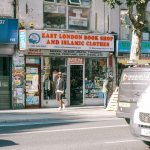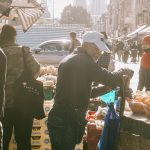In 2017, a study carried out by the Trust for London and New Policy Institute found that 57% of children in the London Borough of Tower Hamlets lived in poverty – the highest rate in London followed by poor levels educational attainment and a 7.2% unemployment rate.
Despite this Tower Hamlets is one of the most fascinating places in the country, I have put together this visual archive which can be used and viewed by future generations when assessing the Borough in years to come along with a background of the Bengali population and the problems it faces and finally what makes it such integral part of London’s East End. Street photography is essential and a means of documenting Muslim heritage in Britain, in communities and boroughs where Muslims make up a large percentage of the population.
Tower Hamlets resides in London’s East End and is widely considered the ‘heartland’ of the British Bengali community. Majority of its population arrived during the 70s escaping war and poverty after the outbreak of war between East and West Pakistan. With changing immigration laws, the United Kingdom saw a wave of immigrant’s primary from the Sylhet region and settled in places such as Tower Hamlets and Spitalfields. Brick Lane became ‘Banglatown’ and saw the emergence of thriving curry houses and jewellery stores. The borough became the hub for South Asian trade and the wave of Bengali immigrants had formed a community and established successful businesses.
However, this period of success for the new wave Bengalis had coincided with the rise of the National Front, a right – wing skinhead group found by A. K. Chesterton. Street clashes between the NF and South – Asians became a regular occurrence and hatred was further fuelled by Enoch Powell’s infamous ‘Rivers of Blood speech’. The onslaught against those from the Bengali community took a new turn with the death of killing of Altab Ali, in 1978 East London’s Bengalis decided to fight back and this was seen across the UK, the infamous “Battle of Lewisham” along with the 1985 Handsworth riots shows us that between the mid-70s and late 80s ethnic minorities in the UK had enough.
Altab Ali had come from Bangladesh and lived just off Brick Lane, in 1978 he was stabbed to death by three teenagers. During the trial, the attackers confessed to killing Altab because he was a “Paki”. Fast forward to today and Brick Lane no longer has the sort of racism which existed during the 70s but is a cultural hub full vintage clothing shops and trendy artwork. Brick Lane attracts tourists from all over the world. The above gallery shows the life and fullness of Whitechapel, from business owners to market traders.
Tower Hamlets still faces the same economic issues which plagued the borough when the first wave of immigrants arrived, nowhere in London can one see the wealth divide, just walk down Whitechapel markets and turn around, and you can see London’s financial district in the distance , home to some of the wealthiest individuals and organisations in all of Europe.
Author: Kaasim Ali
Instagram: @Kaasim73















Comments are closed.